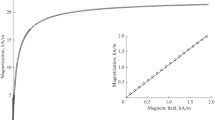Abstract
The magnetic contribution of the solvent on the RT ac magnetic susceptibility behaviour of Fe3O4 magnetic nanoparticles in solution at different concentrations, is presented and discussed. The room temperature complex susceptibility of the solvent water was studied as a function of several parameters, namely different ac fields, superimposed dc fields, different pHs and temperature: in any case a transition from a diamagnetic behaviour to a paramagnetic one at a characteristic frequency (~4,500 Hz) was observed. These results were compared with the data obtained for other common organic solvents. A dependence of the complex magnetic susceptibility from the polarity of the solvent was observed. The results were discussed in terms of a paramagnetic contribution of polarization to the whole measured susceptibility proportional to the applied frequency. For the real and imaginary susceptibility of water at room temperature, empirical polynomial equations as a function of the frequency were obtained. On the basis of these fits, the observed complex susceptibilities of the different nanoparticles solutions were corrected from the solvent contribution and the results are presented.







Similar content being viewed by others
References
Chung SH, Hoffmann A, Bader SD, Liu C, Kay B, Makowski L, Chen L (2004) Biological sensors based on Brownian relaxation of magnetic nanoparticles. Appl Phys Lett 85:2971–2973
Connolly J, St Pierre TG (2001) Proposed biosensors based on time-dependent properties of magnetic fluids. J Magn Magn Mater 225:156–160
Debye P (1929) Polar molecules. Chemical Catalog Company, New York
Enpuku K, Tanaka T, Tamai Y, Matsuo M (2009) AC susceptibility of magnetic markers in suspension for liquid phase immunoassay. J Magn Magn Mater 321:1621–1624
Fischer B, Huke B, Lucke M, Hempelmann R (2005) Brownian relaxation of magnetic colloids. J Magn Magn Mater 289:74–77
Hergt H, Hiergeist R, Hilger I, Kaiser WA, Lapatnikov Y, Margel S, Richter U (2004) Maghemite nanoparticles with very high AC-losses for application in RF-magnetic hyperthermia. J Magn Magn Mater 270:345–357
Kuipers BW, Bakelaar IA, Klokkenburg M, Herné BH (2008) Complex magnetic susceptibility setup for spectroscopy in the extremely low-frequency range. Rev Sci Instrum 79:013901
O’Handley RC (2000) Modern magnetic materials: principles and applications. Wiley, New York
Riani P, Napoletano M, Canepa F (2011) Synthesis, characterization and a.c. magnetic analysis of magnetite nanoparticles. J Nanopart Res 13:7013–7020
Stromberg M, Gunnarson K, Valizadeh S, Svedlinch P, Strømme M (2007) Aging phenomena in ferrofluids suitable for magnetic biosensor applications. J Appl Phys 101:023911
Toledo EJL, Ramalho T, Magriotis ZM (2008) Influence of magnetic field on the physical–chemical properties of the liquid water: insights from experimental to theoretical models. J Mol Str 888:409–415
Tsukada K, Kiwa T, Masuda Y (2006) AC magnetic properties of large volume of water—susceptibility measurements in unshielded environment. Jpn J Appl Phys 45:L1097
Vonsovskii SV (1972) Magnetism, Part II “Magnetic properties of substances without magnetic ordering. Weakly magnetic substances (diamagnets and paramagnets)”, vol 1. Wiley, New York
Acknowledgments
The authors gratefully acknowledged Dr. Ing. Fabrizio Barberis (DICAT—Dipartimento di Ingegneria delle Costruzioni, dell’Ambiente e del Territorio—Università di Genova) for his interest in this study.
Author information
Authors and Affiliations
Corresponding author
Rights and permissions
About this article
Cite this article
Lucchini, M.A., Canepa, F. Brownian relaxation of magnetic nanoparticles in fluid: the effect of the solvent. J Nanopart Res 14, 809 (2012). https://doi.org/10.1007/s11051-012-0809-5
Received:
Accepted:
Published:
DOI: https://doi.org/10.1007/s11051-012-0809-5




